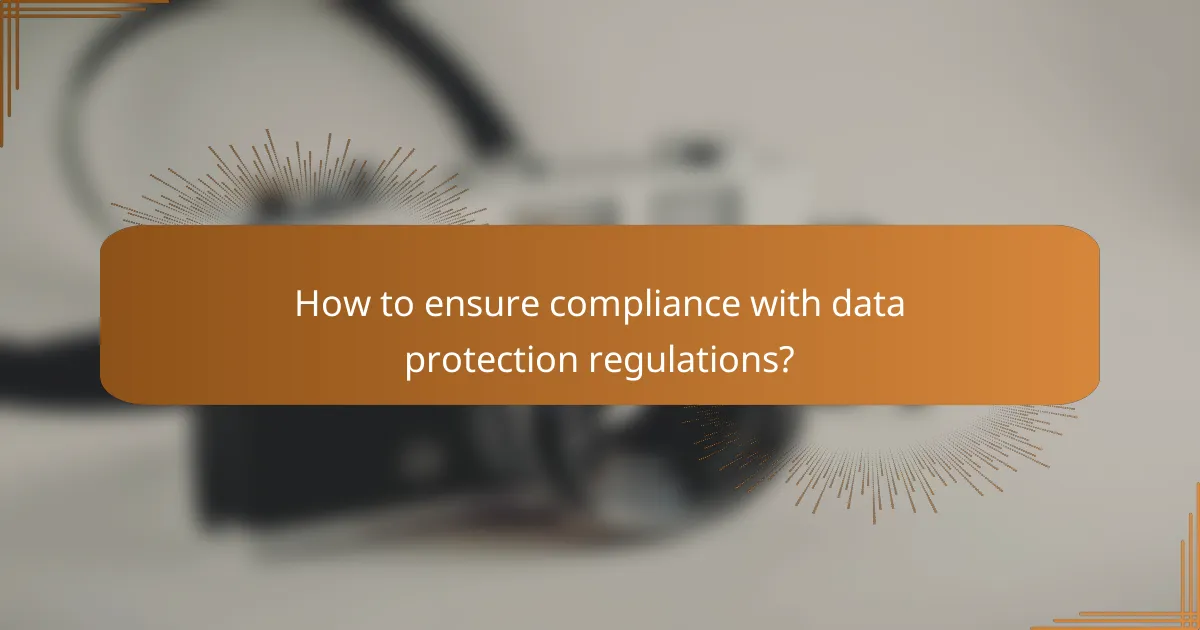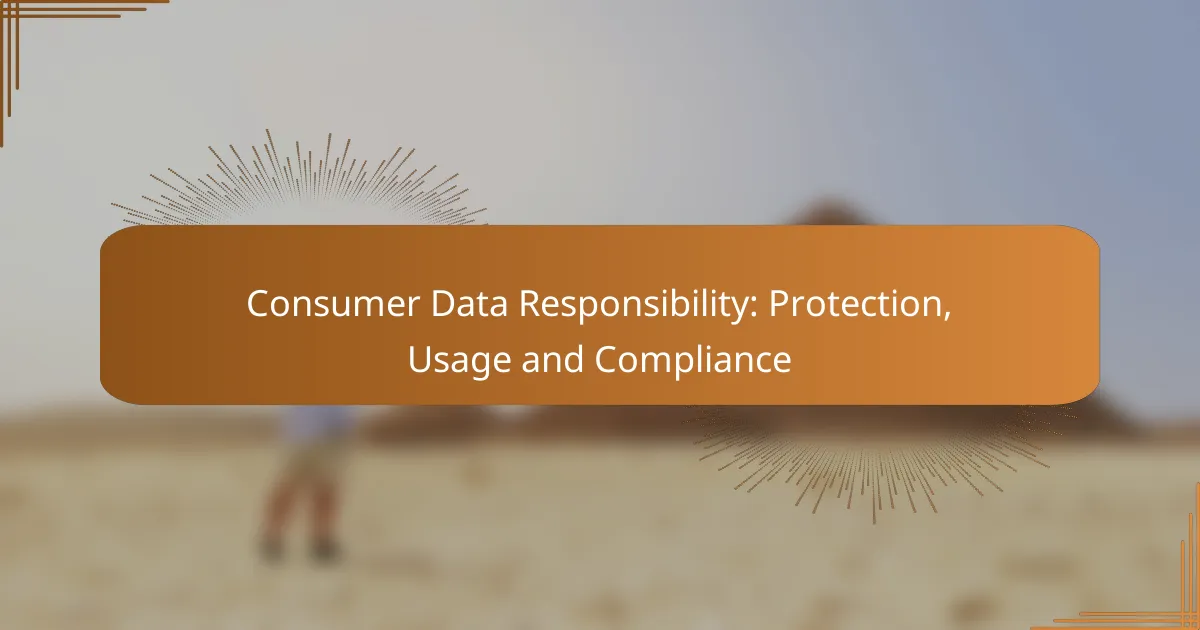In today’s digital landscape, consumer data protection is paramount, particularly in display advertising where personal information is at risk. Organizations must implement robust security measures, such as data encryption and strong access controls, to safeguard this information. Additionally, responsible data usage practices, including obtaining consent and employing anonymization, are essential for maintaining consumer trust and compliance with regulations.

How to protect consumer data in display advertising?
Protecting consumer data in display advertising involves implementing robust security measures to safeguard personal information from unauthorized access and breaches. Key strategies include data encryption, secure storage, strong access controls, regular updates to security protocols, and comprehensive training for staff.
Implement data encryption
Data encryption transforms sensitive information into a secure format that can only be read by authorized users. This process is crucial for protecting consumer data during transmission and storage, ensuring that even if data is intercepted, it remains unreadable without the proper decryption key.
Utilize encryption standards such as AES (Advanced Encryption Standard) for strong protection. Regularly review and update encryption methods to stay ahead of emerging threats and vulnerabilities.
Utilize secure data storage solutions
Secure data storage solutions are essential for protecting consumer data from unauthorized access. Consider using cloud services that comply with industry standards and regulations, such as GDPR or CCPA, which emphasize data protection and privacy.
Evaluate options like encrypted databases and secure servers that offer built-in security features. Regularly audit your storage solutions to ensure they meet current security requirements and best practices.
Adopt strong access controls
Implementing strong access controls limits who can view or manipulate consumer data. Use role-based access controls (RBAC) to ensure that only authorized personnel have access to sensitive information based on their job responsibilities.
Regularly review access permissions and remove access for employees who no longer need it. Employ multi-factor authentication (MFA) to add an extra layer of security, making it harder for unauthorized users to gain access.
Regularly update security protocols
Keeping security protocols up to date is vital for protecting consumer data against new threats. Regularly assess your security measures and update them based on the latest industry standards and emerging cyber threats.
Establish a routine for reviewing and testing your security protocols, including penetration testing and vulnerability assessments. This proactive approach helps identify weaknesses before they can be exploited.
Conduct data protection training
Training employees on data protection practices is crucial for maintaining a secure environment. Regular training sessions should cover topics such as recognizing phishing attempts, secure data handling, and compliance with data protection regulations.
Encourage a culture of security awareness within your organization. Use real-world examples and scenarios to illustrate the importance of protecting consumer data and the potential consequences of negligence.

What are the best practices for data usage?
The best practices for data usage focus on ensuring that consumer data is handled responsibly and ethically. This involves obtaining consent, limiting data collection, employing anonymization, and regularly reviewing policies to maintain compliance and trust.
Obtain explicit user consent
Obtaining explicit user consent is crucial for ethical data usage. This means clearly informing users about what data will be collected, how it will be used, and obtaining their agreement before any data collection occurs.
To ensure compliance, provide users with easy-to-understand consent forms and allow them to opt-in or opt-out of data collection. Avoid pre-checked boxes and vague language to enhance transparency.
Limit data collection to necessary information
Limiting data collection to only what is necessary helps protect consumer privacy and reduces risk. Assess what data is essential for your operations and avoid collecting extraneous information that may not serve a clear purpose.
For example, if you are running a retail website, only collect data such as name, email, and shipping address rather than additional personal details that are not required for processing orders.
Use anonymization techniques
Using anonymization techniques protects individual identities while still allowing for data analysis. This can involve removing personally identifiable information (PII) or aggregating data to prevent tracing it back to individuals.
Consider methods such as data masking, pseudonymization, or generalization to ensure that the data cannot be linked back to specific users, thus enhancing privacy and compliance with regulations.
Regularly review data usage policies
Regularly reviewing data usage policies is essential to adapt to changing regulations and best practices. Conduct audits to ensure that your data handling practices align with current laws and industry standards.
Set a schedule for policy reviews, such as annually or biannually, and involve stakeholders from various departments to ensure comprehensive oversight. This proactive approach helps maintain consumer trust and mitigates legal risks.

How to ensure compliance with data protection regulations?
To ensure compliance with data protection regulations, organizations must understand and implement the relevant laws, conduct regular audits, and maintain clear privacy policies. This proactive approach minimizes legal risks and builds trust with consumers.
Understand GDPR requirements
The General Data Protection Regulation (GDPR) mandates strict guidelines for data handling within the European Union. Key requirements include obtaining explicit consent from individuals before processing their data and ensuring that data is stored securely.
Organizations must also appoint a Data Protection Officer (DPO) if they handle large volumes of personal data. Non-compliance can result in hefty fines, often reaching up to 4% of annual global turnover or €20 million, whichever is higher.
Implement CCPA guidelines
The California Consumer Privacy Act (CCPA) provides California residents with rights regarding their personal information. Businesses must inform consumers about the data collected and allow them to opt-out of the sale of their data.
Additionally, companies must provide clear methods for consumers to access their data and request deletion. Failing to comply can lead to penalties ranging from $2,500 to $7,500 per violation.
Conduct regular compliance audits
Regular compliance audits are essential for identifying gaps in data protection practices. These audits should assess data collection methods, storage security, and adherence to privacy policies.
Organizations should schedule audits at least annually and after any significant changes in data processing activities. This proactive measure helps to ensure ongoing compliance and mitigate potential risks.
Maintain transparent privacy policies
Transparent privacy policies are crucial for building consumer trust and ensuring compliance with regulations. These policies should clearly outline what data is collected, how it is used, and the rights of consumers regarding their data.
It is advisable to review and update privacy policies regularly, especially when there are changes in data handling practices or regulations. Clear communication can help avoid misunderstandings and foster a positive relationship with consumers.

What frameworks support responsible data management?
Responsible data management is supported by various frameworks that help organizations protect consumer data while ensuring compliance with regulations. These frameworks guide businesses in assessing risks, implementing protective measures, and fostering a culture of privacy.
Data Protection Impact Assessments (DPIAs)
Data Protection Impact Assessments (DPIAs) are tools used to identify and mitigate risks associated with data processing activities. They are particularly important when implementing new projects or technologies that may affect personal data privacy.
To conduct a DPIA, organizations should follow key steps: identify the data processing purpose, assess the necessity and proportionality of the processing, evaluate risks to individuals, and determine measures to mitigate those risks. This process helps ensure compliance with regulations like the GDPR.
Privacy by Design principles
Privacy by Design principles advocate for integrating privacy into the development of products and services from the outset. This proactive approach ensures that consumer data protection is a fundamental consideration rather than an afterthought.
Key principles include minimizing data collection, ensuring data security, and providing transparency to users about how their data is used. Organizations can implement these principles by adopting practices such as data anonymization and implementing strong access controls.

What are the consequences of non-compliance?
Non-compliance with consumer data regulations can lead to severe repercussions, including legal penalties, reputational damage, and loss of consumer trust. Organizations must understand the risks associated with mishandling consumer data to avoid these consequences.
Legal penalties and fines
Legal penalties for non-compliance can vary widely depending on the jurisdiction and the severity of the violation. For instance, companies in the European Union may face fines up to 4% of their annual global revenue under the General Data Protection Regulation (GDPR).
In the United States, penalties can differ by state and regulation, with some states imposing fines ranging from thousands to millions of dollars for breaches of consumer data laws. Organizations should stay informed about the specific laws applicable to their operations to mitigate risks.
To avoid legal penalties, companies should implement robust data protection measures, conduct regular compliance audits, and provide employee training on data handling practices. Establishing a clear data governance framework can also help in maintaining compliance and reducing the likelihood of penalties.



